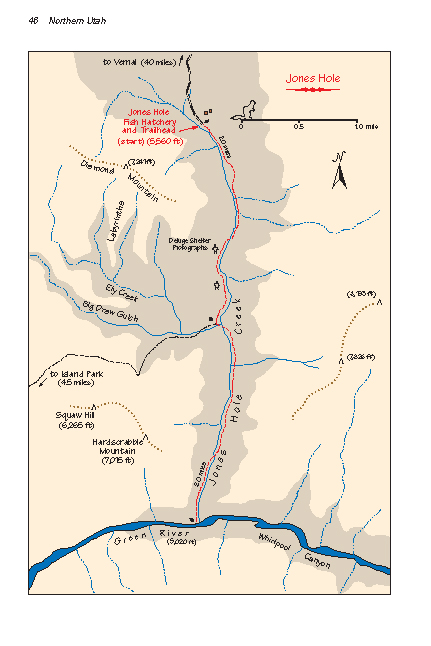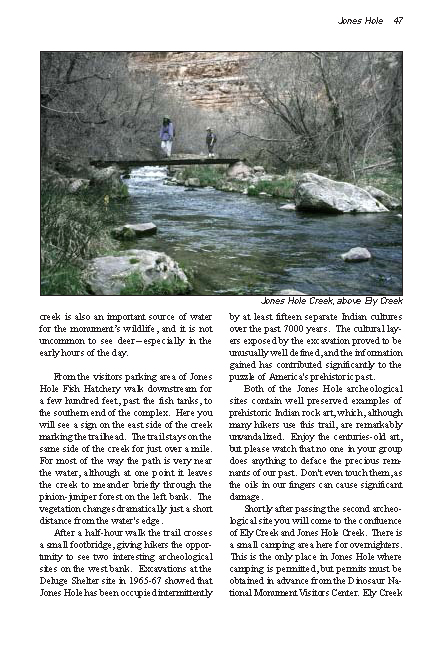|
Links to other sites:
Do you have any recent information to add about this trail?
Ordering books & Maps
Comments about this site or our book:

|
Jones Hole is the name given
to a 2,000-foot-deep gorge that runs along the border between
Utah and Colorado in Dinosaur National Monument. Jones Hole Creek,
in the bottom of the gorge, is fed from a number of small springs
at the head of the canyon and along its sides. The trail begins
just below the first spring, at the Jones Hole Fish Hatchery,
and winds pleasantly along the creek for about four miles to
join the Green River in Whirlpool Canyon. The creek bed is a
lush green oasis surrounded by the semiarid land of Dinosaur
National Monument. At times the trail climbs away from the water
into the sagebrush and pinion-juniper forest that surrounds it,
but mostly it stays very close to the canyon floor where boxelders,
cottonwoods, and other water-hungry trees prevail. The creek
is also an important source of water for the monument’s
wildlife, and it is not uncommon to see deer-especially in the
early hours of the day.
From the visitors parking area
of Jones Hole Fish Hatchery walk downstream for a few hundred
feet, past the fish tanks, to the southern end of the complex.
Here you will see a sign on the east side of the creek marking
the trailhead. The trail stays on the same side of the creek
for just over a mile. For most of the way the path is very near
the water, although at one point it leaves the creek to meander
briefly through the pinion-juniper forest on the left bank. The
vegetation changes dramatically just a short distance from the
water's edge.
After a half-hour walk the trail
crosses a small footbridge, giving hikers the opportunity to
see two interesting archeological sites on the west bank. Excavations
at the Deluge Shelter site in 1965-67 showed that Jones Hole
has been occupied intermittently by at least fifteen separate
Indian cultures over the past 7000 years. The cultural layers
exposed by the excavation proved to be unusually well defined,
and the information gained has contributed significantly to the
puzzle of America's prehistoric past.
Both of the Jones Hole archeological
sites contain well preserved examples of prehistoric Indian rock
art, which, in view of the many hikers that use the trail, are
remarkably unvandalized. Enjoy the centuries-old art, but please
watch that no one in your group does anything to deface the precious
remnants of our past. Don't even touch them, as the oils in our
fingers can cause significant damage.
Shortly after passing the second
archeological site you will come to the confluence of Ely Creek
and Jones Hole Creek. There is a small camping area here for
overnighters. This is the only place in Jones Hole where camping
is permitted, and permits must be obtained in advance from the
Dinosaur National Monument Visitors Center. Open fires are not
permitted. Ely Creek is also worth exploring. It flows out of
an area known as the Labyrinths, a rugged maze of backcountry
canyons, only about a mile northwest of the confluence.
Sharp-eyed hikers may notice a
change in the geological structure of Jones Hole as they pass
Ely Creek. Above this point the canyon cuts through the Weber
Sandstone formation, while below Ely the canyon floor enters
an older formation of limestone and shale. This 200-million-year-old
sedimentary formation bears testimony to the existence of an
ancient sea that once covered the area, and fossil remains of
the sea’s inhabitants can often be found in the limestone.
The trail ends two miles below
Ely Creek where Jones Hole Creek joins the Green River. If you
are hiking in the summer you will probably see at least one party
of river runners here. The Green River is very popular with rafters,
and Jones Hole is a favorite overnight stop. There are several
camp sites nearby, but the sites are reserved for rafters and
are off limits to hikers.
Island Park
An interesting extension to this
hike, for those wishing to sample the semidesert environment
above Jones Hole, is the trail connecting Jones Hole to Island
Park. This trail leaves Jones Hole from the backpacker’s
campground and follows Ely Creek for about a half mile. It then
climbs 800 feet up the south side of Big Draw Gulch to the plateau
above and continues in a generally southwesterly direction. Beyond
this climb the trail is not difficult, but ample water should
be carried as it is a hot, dry walk. The trail ends in Island
Park near Ruple Ranch, 6.5 miles from the Ely Creek Campground.
With a little advance planning a car can be spotted at Ruple
Ranch for the drive back to the trailhead at Jones Hole Fish
Hatchery. An 18-mile-long gravel road leads from Ruple Ranch
to the paved Jones Hole Road, and from there it is another 33
miles back to the fish hatchery.
The first two miles of the trail
from Jones Hole to Island Park are well defined. Unfortunately,
however, the Park Service no longer maintains the trail, and
in a few places above Big Draw Gulch it can be difficult to follow.
If you want to do this hike I recommend you take along a compass
and a good map of the area (the USGS Jones Hole and Island Park
quadrangles are ideal). The area is fairly flat and obstacle-free,
so loosing the trail is not a serious problem if you have a compass
and a good map.
One of the things that makes the
Island Park hike so interesting is the extremely large number
of deer in the area-especially in the spring. In the spring of
1995 I counted more than 50 deer (mostly doe with their newborn
fawns) within a mile of Ruple Ranch!
One final note: Their seems to
be a large disagreement over the distance from Jones Hole to
Ruple Ranch. One Park Service signs says 8.0 miles, another says
4.7 miles, and a popular map says 7.7 miles. I stand by my estimate
of 6.5 miles. |

